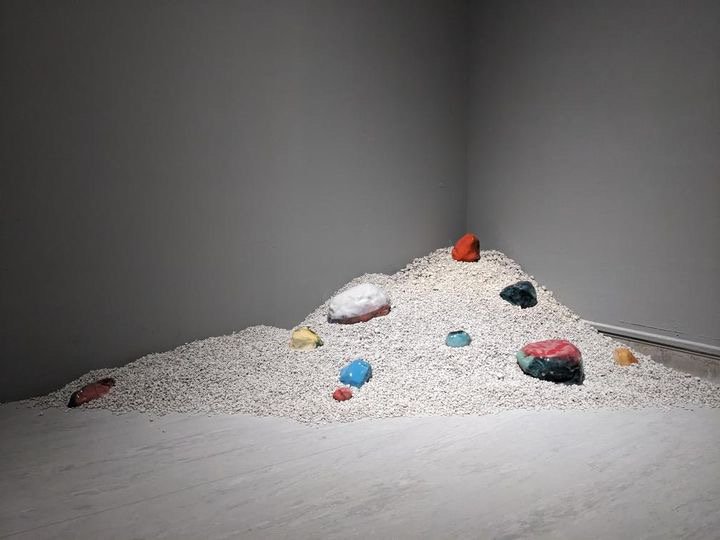Geopoetics: Changing Nature of Threatened Worlds
Geopoetics: Changing Nature of Threatened Worlds
Date:2023/12/02(Sat)~2024/03/10(Sun)
Time: Tue.-Fri. 09:00~17:00, Sat.-Sun. 09:00~18:00
Locations:Gallery 102, 202, NTMoFA
Curators:Patrick Flores 、Kim Seong-Youn 、Hsieh Pei-Chun
About the exhibition
In his poem I’m Not Gonna Talk to You about It, poet Wu Cheng uses three negative sentences to unlock the political potential of the following three things: poetry, life experience, and modern society. He reminds us that we’ll get closer to poetics as soon as we cease our empty rhetoric and interpretations in a cramped room, start to approach natural creatures and open fields of production, and try to extend the space-time for objects and humans through our senses.
Titled “Geopoetics: Changing Nature of Threatened Worlds,” this exhibition owes its inspiration to the idea that nothing can be more optimal than poetry to be the rendezvous for the private and the public as well as for introspection and extroversion. This exhibition not only advocates a poetic survey into the material conditions of East and Southeast Asia in postwar geopolitics, but also unravels contemporary art’s critical perspective withinin the landscpae of anti-poetics.On the basis of geopolitics, the term “geopoetics” further accentuates “form-making,” i.e., the shared similarity between geospatial distribution and poetic formation, so as to extend our concern over East and Southeast Asia in terms of international politico-economic issues like nation, region, and the center-periphery structure.
As we employ poetics to imply the likeness between world-making and form-making, we’ll discover that artistic creation bears more than a passing resemblance to geospatial reshuffle, and that natural / artificial landscapes can be analogized to aesthetic propositions. In this sense, poetic practice seems to emancipate Asia from unduly dogmatic geopolitics and ideology, which ergo offers alternative political potential for artistic creation.
地緣詩學:瀕危世界的多變特質
展覽日期:2023年12月02日至2024年03月10日
展覽時間:週二至週五 09:00~17:00、週六、週日 09:00~18:00
展覽地點:本館102, 202展覽室
開 幕 式:2023/12/02 (六) 14:30
策 展 人:Patrick.Flores 派屈克.佛洛雷斯 、Kim Seong-Youn 金聖淵、謝佩君Hsieh Pei-Chun
=================================================================================
展覽簡介:
詩人吳晟在《我不和你談論》一詩中以三個否定句開啟詩、每日生活經驗與現代社會的政治潛能。詩人提醒我們,當暫停斗室中的空口談論、詮釋,而開始臨近田野萬物與生產場址,嘗試以感官擴延物與人的時態與空間時,我們同時也更接近了詩學。本展覽「地緣詩學:瀕危世界的多變特質」,以詩作為再理想不過、私人與公眾、內省與外揚的會面點為靈感,提倡以一場詩性的踏查,重新丈量東亞與東南亞自二戰後地緣政治的物質情狀,並爬梳當代藝術的批判性視野如何浮現於反詩學的地景之中。奠基於地緣政治的概念,「地緣詩性」一詞進一步強調地理空間分佈與詩學形塑的相似性——造型(form-making),以擴延我們對東亞與東南亞國族、區域、中心與邊陲等國際政經關係下的關懷。當我們以詩學暗示製造世界地域(world-making)與造型的相似性時,我們將會發現藝術創造仿若重組空間地理,而自然/人造的地形景觀一如美學主張(aesthetic proposition)。而過於武斷的亞洲地緣政經情狀與意識形態,似乎也在詩學的實踐下解套,進而讓藝術創造擁有另類的政治潛能。
參展藝術家| Artists
1. Pei-Hang Benoît 黃沛涵(臺灣)
2. Chang Ling 常陵(臺灣)
3. Chang Wen-Hsuan 張紋瑄(臺灣)
4. Chen Ting-Jung 陳庭榕(臺灣)
5. Kamata Yusuke 鎌田友介
6. Kuo Yu-Ping 郭俞平
7. Viet Le 黎越
8. Lee Yong Baek 李庸白
9. Jet Leyco 傑特.萊科
10. Maharani Mancanagara 馬哈拉尼.馬羌那嘎拉
11. Moon & Jeon 文敬媛 & 全濬皓
12. Nira Pereg 妮拉.裴瑞克
13. Seo Pyoung-Joo 徐平周
14. Prateep Suthathongthai 帕蒂普.蘇薩桑泰
15. Wang Hsiang-Lin 王湘靈
(依英文姓氏字母順序排列 In alphabetical order by English surname)



